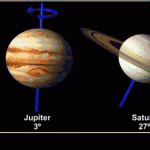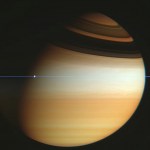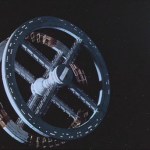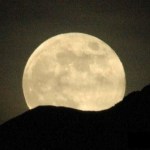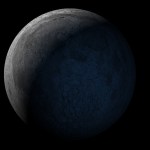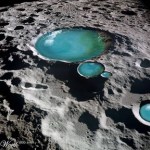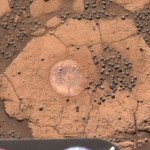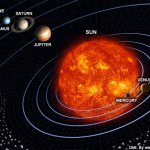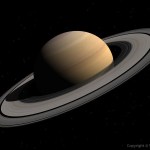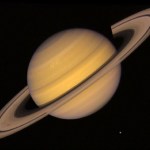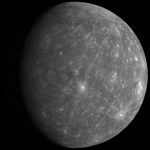Solar System
When you get into a tight place and everything goes against you, till it seems as though you could not hang on a minute longer, never give up then, for that is just the place and time that the tide will turn. -Harriet Beecher Stowe
Last week, our longtime reader Pamela asked if I could explain how the tides work. As you all know, when the tide comes in at the ocean, the water level appears to rise (and can do so significantly), while at low tide, the water level appears to drop.
This goes in a cycle twice per day, with the ocean level reaching its highest point twice daily (high tide),…
We used to think Pluto was a misfit. -Alan Stern
Eighty years ago, we solidly had eight planets in the Solar System: the same eight we have now.
But in the late 1920s, a young astronomer was looking up at the sky, night after night, searching for tiny moving objects that could possibly be planets out beyond Neptune. Using this technique of looking at a patch of sky repeatedly over the course of a week, Clyde Tombaugh searched for moving objects, finding many comets and asteroids, but -- like everyone else -- found no signs of a new planet.
Until January of 1930. I've managed to dig up Clyde…
It is marvelous indeed to watch on television the rings of Saturn close; and to speculate on what we may yet find at galaxy's edge. But in the process, we have lost the human element; not to mention the high hope of those quaint days when flight would create ''one world.'' Instead of one world, we have ''star wars,'' and a future in which dumb dented human toys will drift mindlessly about the cosmos long after our small planet's dead. -Gore Vidal
Someone woke up on the wrong side of the bed when they wrote that, didn't you, Mr. Vidal? Because the marvelous is right in front of us. Yesterday's…
What we know about Pluto today could fit on the back of a postage stamp. -Colleen Hartman
Part of the joy of astronomy is, every once in a while, you just get an astoundingly beautiful new picture or video of a foreign planet, star, galaxy or cluster. Pluto, the most distant planet, is among the most elusive.
This picture above was snapped by the Hubble Space Telescope about a decade ago, and shows us Pluto (center) with its large moon Charon and its two smaller moons, Nix and Hydra.
It's pretty difficult to get better resolution pictures of that planet because Pluto is both so far away and…
We shall not cease from exploration and the end of all our exploring will be to arrive where we started... and know the place for the first time. -T.S. Eliot
Yesterday, President Obama delivered his first State of the Union Address, and talked about a number of things that ranged from inspiring to disappointing. But one thing that didn't make it into the address was the rumor that NASA's Constellation program (including the Ares Rocket designed to launch crews) will lose their government funding.
(Please note: what follows is my opinion, and I take responsibility for it.) If this actually…
There are plenty of examples in the music world where a cover of a song is strikingly different from the original and still interesting. Take the song You Spin Me Round, which cracked the top 5 all over Europe and North America when Dead or Alive released it. (Click for video.) 15 years later, Dope released a cover of the song in a completely different style, with an incredibly different feel. Take a listen:
It's a pretty good cover. It's interesting to listen to, it's decidedly different from the original, and it's still instantly recognizable. But by time I get to the end of the…
I'm always happy to receive questions from those of you interested enough to ask them, and every once in a while one of them feels just right to write up an article about it. Today's comes from Brad Walker, who asks about the inside of gas giants. Specifically,
The question pertains to the insides of gas giants like Jupiter... My question is, supposing Jupiter is made of Metallic Hydrogen, and it was dragged close enough to the sun that its atmosphere evaporated, what would be left? How would it go from a very strange non-terrestrial core to a rocky body like CoRoT-7b? Why wouldn't the…
The Sun stood still and the Moon stayed -- and hastened not to go down about a whole day! -Joshua 10:12-13
Did you have a good New Year's Eve? Did you enjoy not just the fireworks and champagne, but also the Blue Moon (2nd full Moon of the month) that was out that night?
Were you in a fortunate enough part of the world that you not only saw the full Moon, but also managed to see the partial lunar eclipse that happened?
How this happened is pretty simple: the full Moon is always on the opposite side of the Earth from the Sun. When the side of the Moon that's lit up faces Earth, we see it as…
Wow. In xkcd 681 comic, there is an impressive illustration of the common term "gravity well". Here is a small part of that large image:
I can't resist. I must talk about this awesome illustration. My goal for this post is to help someone understand that comic (although the comic itself does a pretty good job).
Energy
Energy is the key here. Here, I will talk about two types of energy - kinetic energy and field energy. In this case, kinetic energy is basically just the energy associated with something moving. Field energy is the energy stored in the gravitational field. You could…
Watch me as I gravitate (hahahahaha). -Gorillaz
Gravity -- unbelievably -- is the weakest force of all. But if you get enough mass together, gravity will overwhelm even the strongest outside influence. A simple case-in-point? You take a rock that's massive enough, and gravity will crush it into a spherical shape,
like it was nothing more than a drop of water.
And here we live on the surface of one of the smaller gravity balls in our Solar System. XKCD has a wonderful illustration of this today (and click for full-size).
The more massive and more compact your planet is, the harder it is to…
The solar system is difficult to show correctly. Why? It is difficult because the size of things are vastly different. Let me use units common in solar-system astronomy, the Astronomical Unit (or AU). One AU is the distance from the Sun to the Earth. If I want to look at all the planets, I would need to go out to about 30 AU (to Neptune - remember that Pluto is not a planet). That is not a problem but then if I want to look at the size of even the Sun, it is just 0.001 AU across. And the Earth is even smaller, at 0.0001 AU. So that is the problem. The distance from the Sun to Neptune…
I thought I should consult you first before I went ahead with my plan to destroy the Moon. -Greg Angelone, via The Straight Dope
Last week, scientists from LCROSS announced that they had detected "a buttload" of water on the Moon. Let's go over what happened and what it means.
The Moon is very different from Earth. It has no atmosphere (literally, less than one atom thick), day-and-night lasts for two weeks apiece, and the temperature extremes are horrifically severe. But one of the biggest differences? Whereas the Earth is tilted at 23.5 degrees as it goes around the Sun, the Moon is tilted…
Yesterday, I talked about why we should look for a history of life on Mars, and had an article for SEED magazine to that effect. After all, we've made some recent geological finds that are surefire indicators of past liquid water on Mars, and possible indicators of past life.
While most of the article was about Mars' history as a planet and the argument that in the past, it was much more Earth-like than it is today, I had one sentence that appears to have touched off a firestorm in the comments:
I don't know whether there was life on Mars or not, but based on what I know about abiogenesis…
The Mars Polar Lander cost the average American the price of half a cheeseburger. A human lander would cost the average American more -- perhaps even ten cheeseburgers! So be it. That is no great sacrifice.
-JONAH GOLDBERG, National Review Online, May 3, 2000
This week, Seed Magazine is doing a special on extraterrestrial life in the Universe. They cover a lot of ground, including whether life would necessarily look like life on Earth, where the likely places are to find it, and endeavors towards that end.
And they approached me to write an article for them about Mars. An excerpt is below:…
In 1908, a huge fireball streaked across the sky and exploded a few kilometers above the Earth's surface, downing trees for miles and miles around but leaving no impact crater on the ground. This mystery was known as the Tunguska event.
But how did this happen? The amount of energy released was estimated to be somewhere between 5 and 30 Megatons of TNT. (Comparably to a "typical" hydrogen bomb.) What could've caused this devastation?
My answer: a large meteor or small asteroid/comet could have done this easily. How? Let me explain.
When a meteor enters Earth's atmosphere, it's moving very,…
Ever see a picture of a Solar Prominence before? If you have, you'll recognize these loop-like features leaving the Sun's surface and ending up in the Sun's corona:
Well two spacecraft designed to monitor the Sun, Stereo A (which stands for "Ahead" of Earth) and Stereo B (which stands for "Behind") just imaged a 30-hour Solar Prominence during September 26th and 27th. What did they find?
This video, which gives three minutes worth of spectacular views of this eruption on the Sun. Have a look:
Thanks to APOD for providing the snapshot that inspired this!
It's only natural to wonder why things are the ways that they are. Take a look at our Solar System, for example.
A central bulge with planets, moons, and whatnot moving in a disc around it. Is this the way things have to be? My friend Rich, a chemist, asks:
It seems that all the objects in our solar system orbit the sun in nearly the same plane. Why is that? Why doesn't the solar system have spherical symmetry?
In particular, Rich wants to know why our Solar System doesn't look more like this:
Our Solar System is definitely not shaped like a sphere; it definitely is a bulge at the center…
My Very Educated Mother Just Served Us Nine Pickles.
--Children everywhere, up until very recently
Taking a look at the new ring discovered around Saturn made me realize something. Most of us don't realize how full of crap our Solar System is.
I don't mean planets, or moons, or comets or asteroids, although there are certainly plenty to go around. A brief recap of what happened around Saturn first. Saturn has seven glorious, inner rings that we're familiar with, that make it a magnificent sight for skywatchers everywhere.
If you look closely at this image, you will see a few white dots in…
One ring to rule them all,
one ring to find them.
One ring to bring them all
and in the darkness bind them. --J.R.R. Tolkien
Of course we're all familiar with the planet Saturn. Gas giant, many moons, and, of course, its prominent rings:
Note that word, rings. Sure, at a distance, it may just look like one elongated ring.
But our tools for measurement are better than our mere naked eyes. Saturn was known, very clearly, to have seven separate rings, many of which are separated by large moons in their orbits.
But very recently, a team of astronomers from Maryland and Virginia have discovered…
As you may have noticed, there's a new super-high resolution mosaic of the planet Mercury that's available.
How high resolution is it? Perhaps you should join me on my journey as I zoom in to the upper left hand corner. (Click each image to view it full-size.)
While Mercury may look unevenly cratered, keep in mind that there's a trick of the light going on here. When you're close to the limit of where the Sun's rays reach (the terminator), angles are lower and shadows are longer, making craters appear more pronounced.
In reality, there are "young" regions all over Mercury, where more…

